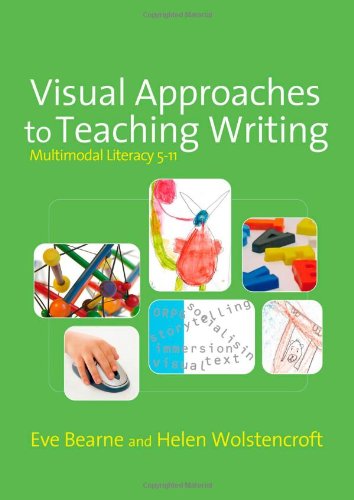

Most ebook files are in PDF format, so you can easily read them using various software such as Foxit Reader or directly on the Google Chrome browser.
Some ebook files are released by publishers in other formats such as .awz, .mobi, .epub, .fb2, etc. You may need to install specific software to read these formats on mobile/PC, such as Calibre.
Please read the tutorial at this link. https://ebooknice.com/page/post?id=faq
We offer FREE conversion to the popular formats you request; however, this may take some time. Therefore, right after payment, please email us, and we will try to provide the service as quickly as possible.
For some exceptional file formats or broken links (if any), please refrain from opening any disputes. Instead, email us first, and we will try to assist within a maximum of 6 hours.
EbookNice Team

Status:
Available5.0
17 reviews
ISBN 10: 1412930340
ISBN 13: 978-1412930345
Author: Eve Bearne, Helen Wolstencroft
Helps teachers include multimodal approaches in writing instruction, demonstrates how to build a supportive classroom environment for analyzing visual and audiovisual texts, and includes a CD-ROM.
Introduction
Section 1 What are multimodal texts?
Defining and describing multimodal texts
Writing and multimodal texts
Affordance and design
Showing and telling
What children know about multimodality
Activity: Finding out what children know about multimodal texts
Developing a vocabulary to describe multimodal texts
Classroom account: Planning and making picture books with Years 1/2
Activity: Talking about words and pictures
Popular cultural texts and writing
Summary
Section 2 The classroom as an environment for visual and audio-visual texts
Reviewing provision
Activity: Surveying multimodal text provision
Activity: Evaluating multimodal texts
Raising the profile of multimodal texts
Activity: Surveying the profile of multimodal texts in the classroom
Teaching multimodality
Activity: Reviewing multimodal teaching
Provision of digital resources
Activity: Evaluating digital texts
Reading and analysing visual texts
Activity: Reading picture books analytically
The environment of possibility
Summary
Section 3 Planning and teaching multimodal and written texts
Using the Multimodal Planning and Teaching Sequence
Familiarity with the text type
Capturing and recording ideas
Planning and structuring
Drafting, revising and proof reading
Presenting
Teacher modelling
Using the sequence flexibly
Classroom account: Designing and writing non-chronological reports in Year 5
Summary
Section 4 Narrative
Pictures in the mind
Activity: Writing pictures
Using word and image: becoming familiar with text types and capturing ideas
Classroom account: Making illustrated play scripts in Year 2
Starting from the visual: planning narratives
Activity: Mapping narrative structures
Flexible planning using pictures
Activity: The backstory
Activity: Developing character and dialogue
Activity: Creating atmosphere and narrative tension
Activity: Shaping ideas into episodes
Activity: Heroic adventure stories
Writing and film
Pacing narratives
Activity: Using frames to pace a narrative
Classroom account: Making picture books for younger readers with Years 3/4
Summary
Section 5 Non-fiction
What is non-fiction?
Composing non-fiction texts
Designing information
Classroom account: Making information leaflets with Years 3/4
Activity: Analysing design
Activity: Gathering information from words and images
Scaffolds for non-fiction
Activity: Making frames from websites
Research from observation
Classroom account: Researching in the school environment with Years 1/2
Activity: Researching the environment
Persuasive presentation texts
Classroom account: Design presentations in Years 3/4
Summary
Section 6 Poetry
Narrative poetry: starting from images
Classroom account: Using images for writing narrative poetry in a special school
Activity: Narrative poetry using images
Activity: Writing from illustrated narrative poetry
Using film to inspire poetry
Films without words
Activity: Using a film sequence for poetry writing
Poetry across the curriculum
Classroom accounts: Poetry based on close observation of the natural world from Year 1 to Year 5
Activity: Poetry across the curriculum
Sound and image
Classroom account: Presenting pictures and poetry with a Year 6 class
Activity: Making poetry presentations
Writing about poetry
Activity: Adding backgrounds to poetry
Activity: Writing from poetry and image together
Activity: Tempting others to read poetry
Summary
Section 7 Making progress in multimodal composition
Writing development
Differences between assessment and describing progress
A framework for describing and assessing multimodal texts
Examples of different combinations of modes
Activity: Describing and assessing multimodal texts
Activity: Discussing examples
Example 1. Making a picture book: a multimodal text maker in the early stages
Example 2. Writing a picture book drawing on a favourite film: an increasingly assured multimodal text maker
Example 3. Writing an information book: a more experienced and often independent multimodal text maker
Example 4. Writing a collaborative picture book: two assured, experienced and independent multimodal text makers
Example 5. Making a collaborative presentation and writing individual stories: assured, experienced and independent multimodal text makers
Reflecting on progress
Moving multimodal learners on
Activity: Moving children on as multimodal text makers
What does progression in multimodality look like?
Activity: Progress descriptors for multimodal composition
Summary
Section 8 Whole-school policy for multimodal teaching and learning
National developments
Planning for classroom and school development
Reviewing current practice and provision
Innovating and developing
Embedding and extending
Describing children’s progress
Summary
Resources
Author Index
Subject Index
visual teaching techniques
what are the different approaches to teaching writing
writing approaches
visual teaching methods
visual strategies for writing
Tags: Eve Bearne, Helen Wolstencroft, Visual Approaches, Multimodal Literacy